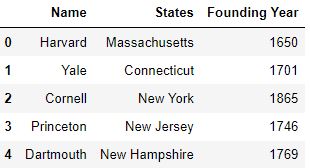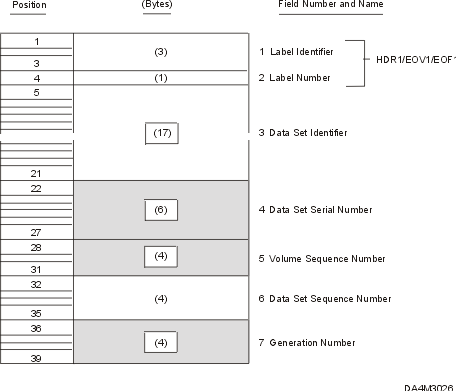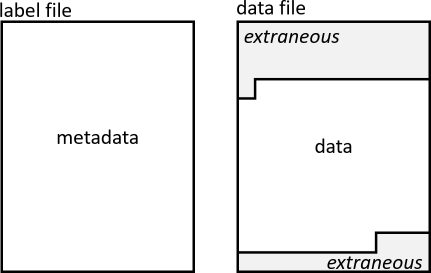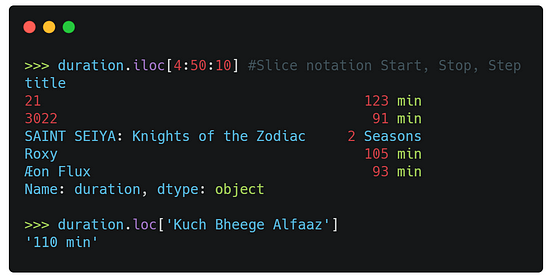38 indexing using labels in dataframe
The Pandas DataFrame: Make Working With Data Delightful This Pandas DataFrame looks just like the candidate table above and has the following features: Row labels from 101 to 107; Column labels such as 'name', 'city', 'age', and 'py-score' Data such as candidate names, cities, ages, and Python test scores; This figure shows the labels and data from df: Indexing a Pandas DataFrame for people who don't like to remember things In pandas data frames, each row also has a name. By default, this label is just the row number. However, you can set one of your columns to be the index of your DataFrame, which means that its values will be used as row labels. We set the column 'name' as our index. It is a common operation to pick out one of the DataFrame's columns to work on.
Pandas Set Column as Index in DataFrame - Spark by {Examples} Use DataFrame.set_index() method to set the existing column of DataFrame as an index. On DataFrame, the row label is an Index. If your DataFrame has already had an Index, this replaces the existing index or expands on it. You can set the DataFrame index (row labels) using one or more existing columns or arrays (of the correct length). Syntax:

Indexing using labels in dataframe
Python Pandas: Get Index Label for a Value in a DataFrame If I know the value in 'hair' is 'blonde', how do I get the index label (not integer location) corresponding to df.ix['mary','hair']? (In other words, I want to get 'mary' knowing that hair is 'blonde'). If I wanted the integer value of the index I'd use get_loc. But I want the label. Thanks in advance. How to Index Data in Pandas with Python - Medium Using Single Label. One way we can specify which rows and/or columns we want is by using labels. For rows, the label is the index value of that row, and for columns, the column name is the label. For example, in our ufo dataframe, if we want the fifth row only along with all the columns, we would use the following: ufo.loc [4, :] Pandas select rows: How to Select Rows from Pandas DataFrame - AppDividend Pandas DataFrame loc property access a group of rows and columns by label(s) or a boolean array. DataFrame.loc[] is primarily label-based but may also be used with a boolean array. Allowed inputs are the following. A single label, e.g., 5 or 'a', (note that 5 is interpreted as a label of the index and never as an integer position along with ...
Indexing using labels in dataframe. How to get the names (titles or labels) of a pandas data frame in python To get the names of the data frame rows: >>> df.index Index(['Alice', 'Bob', 'Emma'], dtype='object') Get the row names of a pandas data frame (Exemple 2) Another example using the csv file train.csv (that can be downloaded on kaggle): >>> import pandas as pd >>> df = pd.read_csv('train.csv') >>> df.index RangeIndex(start=0, stop=1460, step=1) Pandas Select Rows by Index (Position/Label) In this article, I will explain how to select rows from pandas DataFrame by integer index and label, by the range, and selecting first and last n rows with several examples. loc [] & iloc [] operators are also used to select columns from pandas DataFrame and refer to related article how to get cell value from pandas DataFrame. Indexing and Sorting a dataframe using iloc and loc Labels based indexing using loc. To index a dataframe based on column names, loc can be used. For example, to get all the columns between petal_length till iris class and records from 2nd to 10th, can be extracted by using - ... Simples way to sort a dataframe can be done using sort_values function of pandas dataframe, which take the column ... Pandas: Create an index labels by using 64-bit integers, floating-point ... Have another way to solve this solution? Contribute your code (and comments) through Disqus. Previous: Write a Pandas program to display the default index and set a column as an Index in a given dataframe and then reset the index. Next: Write a Pandas program to create a DataFrame using intervals as an index.
Boolean Indexing in Pandas - GeeksforGeeks Jun 08, 2022 · In boolean indexing, we will select subsets of data based on the actual values of the data in the DataFrame and not on their row/column labels or integer locations. In boolean indexing, we use a boolean vector to filter the data. Boolean indexing is a type of indexing that uses actual values of the ... Pandas : Sort a DataFrame based on column names or row index labels ... In the Python Pandas Library, the Dataframe section provides a member sort sort_index () to edit DataFrame based on label names next to the axis i.e. DataFrame.sort_index (axis=0, level=None, ascending=True, inplace=False, kind='quicksort', na_position='last', sort_remaining=True, by=None) Where, How to find index of value in Pandas dataframe - DevEnum.com 2. df.index.values to Find index of specific Value. To find the indexes of the specific value that match the given condition in Pandas dataframe we will use df ['Subject'] to match the given values and index. values to find an index of matched value. The result shows us that rows 0,1,2 have the value 'Math' in the Subject column. Pandas DataFrame Indexing - KDnuggets In pandas data frames, each row also has a name. By default, this label is just the row number. However, you can set one of your columns to be the index of your DataFrame, which means that its values will be used as row labels. We set the column 'name' as our index. It is a common operation to pick out one of the DataFrame's columns to work on.
Pandas Indexing Examples: Accessing and Setting Values on DataFrames Source dataframe select row whose index label is 0 select rows whose index labels are 2 and 3 loc example, string index Use .loc [] to select rows based on their string labels: Pandas DataFrame drop: How to Drop Rows and Columns Jun 01, 2020 · In this example, we have selected 1and 2 rows using iloc[] and removed them from the DataFrame using the drop() method. Dropping Columns using loc[] and drop() method. Pandas DataFrame loc[] function is used to access a group of rows and columns by labels or a Boolean array. The loc() method is primarily done on a label basis, but the Boolean ... How to Select Rows by Index in a Pandas DataFrame - Statology If you'd like to select rows based on label indexing, you can use the .loc function. This tutorial provides an example of how to use each of these functions in practice. Example 1: Select Rows Based on Integer Indexing. The following code shows how to create a pandas DataFrame and use .iloc to select the row with an index integer value of 4: How to Filter a Pandas DataFrame With a Multi-Level Column Index ... The dataframe where data under the "AAPL" column label in the "Close" column is greater than 100. Notice that we used a "." to navigate the first column label.
Tutorial: How to Index DataFrames in Pandas - Dataquest Let's explore four methods of label-based dataframe indexing: using the indexing operator [], attribute operator ., loc indexer, and at indexer. Using the Indexing Operator If we need to select all data from one or multiple columns of a pandas dataframe, we can simply use the indexing operator [].
Indexing and selecting data — pandas 1.4.2 documentation pandas provides a suite of methods in order to have purely label based indexing. This is a strict inclusion based protocol. Every label asked for must be in the index, or a KeyError will be raised. When slicing, both the start bound AND the stop bound are included, if present in the index.
Working With Specific Values In Pandas DataFrame - Data Courses This function of a pandas DataFrame is of high value as you can build an index using a specific column, (meaning: a label) that you want to use for managing and querying your data. For example, one can develop an index from a column of values and then use the attribute.loc to select data from pandas DataFrame based on a value found in the index.
DataFrame — pandas 1.4.2 documentation Get the 'info axis' (see Indexing for more). DataFrame.iterrows Iterate over DataFrame rows as (index, Series) pairs. DataFrame.itertuples ([index, name]) Iterate over DataFrame rows as namedtuples. DataFrame.lookup (row_labels, col_labels) (DEPRECATED) Label-based "fancy indexing" function for DataFrame. DataFrame.pop (item)
How to select subset of data with Index Labels in Python Pandas? With.iloc attribute,pandas select only by position and work similarly to Python lists. The .loc attribute selects only by index label, which is similarto how Python dictionaries work. Select a Subset Of Data Using Index Labels with .loc[] The loc and iloc attributes are available on both Series and DataFrame
Pandas DataFrame Indexing: Set the Index of a Pandas Dataframe Python list as the index of the DataFrame In this method, we can set the index of the Pandas DataFrame object using the pd.Index (), range (), and set_index () function. First, we will create a Python sequence of numbers using the range () function then pass it to the pd.Index () function which returns the DataFrame index object.
User Guide — pandas 1.4.2 documentation Combining positional and label-based indexing; Indexing with list with missing labels is deprecated; Selecting random samples; Setting with enlargement; Fast scalar value getting and setting; Boolean indexing; Indexing with isin; The where() Method and Masking; Setting with enlargement conditionally using numpy() The query() Method; Duplicate data
How to Get the Index of a Dataframe in Python Pandas? Method 1: Using for loop. In Python, we can easily get the index or rows of a pandas DataFrame object using a for loop. In this method, we will create a pandas DataFrame object from a Python dictionary using the pd.DataFrame () function of pandas module in Python. Then we will run a for loop over the pandas DataFrame index object to print the ...
pandas Tutorial => Select distinct rows across dataframe Filtering / selecting rows using `.query()` method; Filtering columns (selecting "interesting", dropping unneeded, using RegEx, etc.) Get the first/last n rows of a dataframe; Mixed position and label based selection; Path Dependent Slicing; Select by position; Select column by label; Select distinct rows across dataframe; Slicing with labels
Boolean Indexing in Pandas - Tutorials Point Now, we can pass the boolean vector to the DataFrame to access the data. Example # passing boolean vector to data_frame index print(data_frame[ [True, True, False]]) Output If run the above code, you will get the following results. We got the row only that is True. Name Age 0 Hafeez 19 1 Srikanth 20 Conclusion
Indexing and Selecting Data with Pandas - GeeksforGeeks Indexing a DataFrame using .loc [ ] : This function selects data by the label of the rows and columns. The df.loc indexer selects data in a different way than just the indexing operator. It can select subsets of rows or columns. It can also simultaneously select subsets of rows and columns. Selecting a single row
How to Select Columns by Index in a Pandas DataFrame If you'd like to select columns based on label indexing, you can use the .loc function. This tutorial provides an example of how to use each of these functions in practice. Example 1: Select Columns Based on Integer Indexing
Python | Pandas DataFrame - GeeksforGeeks Jan 10, 2019 · Indexing a DataFrame using .loc[ ]: This function selects data by the label of the rows and columns. The df.loc indexer selects data in a different way than just the indexing operator. It can select subsets of rows or columns. It can also simultaneously select subsets of rows and columns. Selecting a single row
Indexing in Pandas Dataframe using Python - Medium Indexing using .loc method. If we use the .loc method, we have to pass the data using its Label name. Single Row To display a single row from the dataframe, we will mention the row's index name in the .loc method. The whole row information will display like this, Single Row information Multiple Rows
pandas.DataFrame.set_index — pandas 1.4.2 documentation DataFrame.set_index(keys, drop=True, append=False, inplace=False, verify_integrity=False) [source] ¶ Set the DataFrame index using existing columns. Set the DataFrame index (row labels) using one or more existing columns or arrays (of the correct length). The index can replace the existing index or expand on it. Parameters
Label-based indexing to the Pandas DataFrame - GeeksforGeeks In the above example, we use the concept of label based Fancy Indexing to access multiple elements of data frame at once and hence create two new columns ' Age ' and ' Marks ' using function dataframe.lookup () Example 3: Python3 import pandas as pd df = pd.DataFrame ( [ ['Date1', 1850, 1992,'Avi', 5, 41, 70, 'Avi'],
Set Index in pandas DataFrame - PYnative This function is used to re-assign a row label using the existing column of the DataFrame. It can assign one or multiple columns as a row index. Let's see how to use DataFrame.set_index() function to set row index or replace existing. Syntax. DataFrame.set_index(keys, drop=True, append=False, inplace=False, verify_integrity=False) Parameters















Post a Comment for "38 indexing using labels in dataframe"